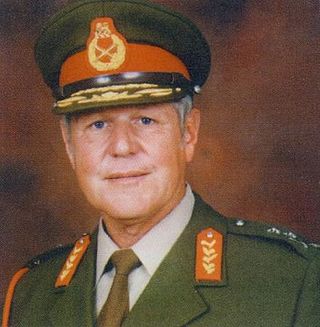Operation Reindeer, which began on 4 May 1978, was South Africa's second major military operation in Angola, carried out under the Apartheid regime, the first being Operation Savannah.
The Battle of Cassinga also known as the Cassinga Raid or Kassinga Massacre was a controversial South African airborne attack on a South West Africa People's Organization (SWAPO) military camp at the town of Cassinga, Angola on 4 May 1978. Conducted as one of the three major actions of Operation Reindeer during the South African Border War, it was the South African Army's first major air assault operation.

General Constand Laubscher Viljoen was a South African military commander and politician. He co-founded the Afrikaner Volksfront and later founded the Freedom Front. He is partly credited with having prevented the outbreak of armed violence by disaffected white South Africans prior to post-apartheid general elections.

The South African Border War, also known as the Namibian War of Independence, and sometimes denoted in South Africa as the Angolan Bush War, was a largely asymmetric conflict that occurred in Namibia, Zambia, and Angola from 26 August 1966 to 21 March 1990. It was fought between the South African Defence Force (SADF) and the People's Liberation Army of Namibia (PLAN), an armed wing of the South West African People's Organisation (SWAPO). The South African Border War was closely intertwined with the Angolan Civil War.
Operation Askari was a military operation during 1983 in Angola by the South African Defence Force (SADF) during the South African Border War.

Operation Seiljag was a South African 32 Battalion search and destroy campaign conducted against the People's Liberation Army of Namibia (PLAN) from November 1976 to March 1977, during the South African Border War. It was carried out from November 1976 to March 1977 largely on the Yati Strip, a region patrolled by South African security forces parallel to the Angolan border. By February, the fighting had intensified and shifted to about fourteen kilometres into Angola. In the course of a four-month period 32 Battalion had eliminated two PLAN sections, repelled a third incursion across the border, and destroyed three militant bases. The bodies of nineteen guerrillas were recovered, in addition to a cache of mortar bombs and RPG-7 projectiles intended for use on PLAN raids.
Operation Prone was a proposed military operation by the South African Defence Force (SADF) and South West African Territorial Force (SWATF) during the South African Border War and Angolan Civil War between May and September 1988. With the advance of the 50th Cuban Division towards Calueque and the South-West Africa border, the SADF formed the 10 SA Division to counter this threat. The plan for Operation Prone had two phases. Operation Linger was to be a counterinsurgency phase and Operation Pact a conventional phase.

Xangongo is a town, with a population of 35,000 (2014), and a commune in the municipality of Ombadja, province of Cunene, Angola.

The Van Riebeeck Medal, post-nominal letters VRM, is a military decoration for bravery which was instituted by the Union of South Africa in 1952. It was awarded to other ranks for distinguished service in the field.

44 Parachute Brigade was a parachute infantry brigade of the South African Army. It was founded on 20 April 1978, by Colonel Jan Breytenbach, following the disbandment of 1 SA Corps and the battle of Cassinga. Upon formation, the brigade was commanded by Brigadier M. J. du Plessis, who was assigned the task of establishing by working with the Parachute Staff Officer, Colonel Jan Breytenbach. At the time du Plessis was the commanding officer of the Orange Free State Command and had previous experience serving in 1 Parachute Battalion. Breytenbach had also been a member of 1 Parachute Battalion and had also founded the South African Special Forces Brigade and 32 Battalion. The location that was chosen for the brigade's headquarters was in the lines of the OFS Cmd Headquarters, next to the old Tempe Airfield in Bloemfontein.

The 44 Pathfinder Platoon is part of the 44 Parachute Regiment. The pathfinder is a trained and specialized paratrooper, who performs covertly behind enemy lines, either in small groups or in collaboration with other reconnaissance units.

Lieutenant General Reginald Otto was a South African military commander, who held the post of Chief of the South African Army.

Major General Roy Cecil Andersen is a South African businessman and a retired Reserve general officer in the South African Army from the artillery. He matriculated from Northview High School and graduated from Witwatersrand University.

The Bagaka Regiment is a reserve airborne infantry regiment of the South African Army.
Andre van Deventer was a South African Army officer who served as the Chief of Staff Finance from 1976 to 1979 and later Secretary of the State Security Council until 1985.
Lieutenant General Phil du Preez is a former Anti-Aircraft officer of the South African Army.
Maj Gen Koos Laubscher was a General Officer in the South African Army from the artillery.
Col Jakes Jacobs was a South African Army officer from the artillery.
Brigadier General Felix Hurter was a General Officer in the South African Army from the artillery. He was born in Port Elizabeth on 28 June 1942.
Maj Gen Chris le Roux is a retired General Officer from the South African Army. He was born in Dundee and matriculated from Pinetown Boys' High School in 1963.








